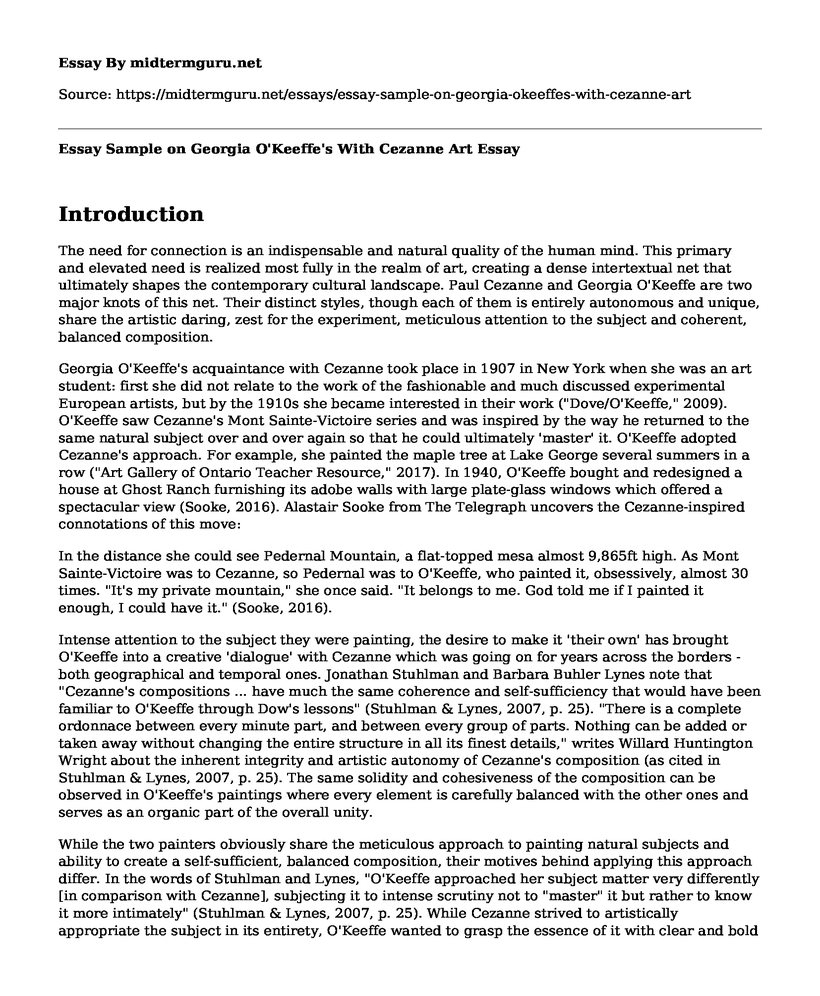Introduction
The need for connection is an indispensable and natural quality of the human mind. This primary and elevated need is realized most fully in the realm of art, creating a dense intertextual net that ultimately shapes the contemporary cultural landscape. Paul Cezanne and Georgia O'Keeffe are two major knots of this net. Their distinct styles, though each of them is entirely autonomous and unique, share the artistic daring, zest for the experiment, meticulous attention to the subject and coherent, balanced composition.
Georgia O'Keeffe's acquaintance with Cezanne took place in 1907 in New York when she was an art student: first she did not relate to the work of the fashionable and much discussed experimental European artists, but by the 1910s she became interested in their work ("Dove/O'Keeffe," 2009). O'Keeffe saw Cezanne's Mont Sainte-Victoire series and was inspired by the way he returned to the same natural subject over and over again so that he could ultimately 'master' it. O'Keeffe adopted Cezanne's approach. For example, she painted the maple tree at Lake George several summers in a row ("Art Gallery of Ontario Teacher Resource," 2017). In 1940, O'Keeffe bought and redesigned a house at Ghost Ranch furnishing its adobe walls with large plate-glass windows which offered a spectacular view (Sooke, 2016). Alastair Sooke from The Telegraph uncovers the Cezanne-inspired connotations of this move:
In the distance she could see Pedernal Mountain, a flat-topped mesa almost 9,865ft high. As Mont Sainte-Victoire was to Cezanne, so Pedernal was to O'Keeffe, who painted it, obsessively, almost 30 times. "It's my private mountain," she once said. "It belongs to me. God told me if I painted it enough, I could have it." (Sooke, 2016).
Intense attention to the subject they were painting, the desire to make it 'their own' has brought O'Keeffe into a creative 'dialogue' with Cezanne which was going on for years across the borders - both geographical and temporal ones. Jonathan Stuhlman and Barbara Buhler Lynes note that "Cezanne's compositions ... have much the same coherence and self-sufficiency that would have been familiar to O'Keeffe through Dow's lessons" (Stuhlman & Lynes, 2007, p. 25). "There is a complete ordonnace between every minute part, and between every group of parts. Nothing can be added or taken away without changing the entire structure in all its finest details," writes Willard Huntington Wright about the inherent integrity and artistic autonomy of Cezanne's composition (as cited in Stuhlman & Lynes, 2007, p. 25). The same solidity and cohesiveness of the composition can be observed in O'Keeffe's paintings where every element is carefully balanced with the other ones and serves as an organic part of the overall unity.
While the two painters obviously share the meticulous approach to painting natural subjects and ability to create a self-sufficient, balanced composition, their motives behind applying this approach differ. In the words of Stuhlman and Lynes, "O'Keeffe approached her subject matter very differently [in comparison with Cezanne], subjecting it to intense scrutiny not to "master" it but rather to know it more intimately" (Stuhlman & Lynes, 2007, p. 25). While Cezanne strived to artistically appropriate the subject in its entirety, O'Keeffe wanted to grasp the essence of it with clear and bold shapes and colors. In Cezanne's still-life paintings one comes across multiple compositional elements including the details of the background, while O'Keeffe experimented with a limited number of objects avoiding complexity and going into too much detail. This fundamental difference led to divergence in terms of the aesthetic effect upon the spectator: "through this reduction, O'Keeffe gave her subjects an iconic quality in contrast to Cezanne's investigation of objects in space" (Stuhlman & Lynes, 2007, p. 25).
O'Keeffe's art obviously benefited from the painter's dialogue with Cezanne. Yet, O'Keeffe managed to use the skills learned form the French artist to fulfill her own aesthetic aims. O'Keeffe's more austere and focused approach towards the primary object of the artistic investigation helped the painter finally make her audience pay attention to such little things as a flower, a stone, a shell, an animal skull and see their intrinsic beauty which shines in the way these objects embody the unfathomable harmony and magnificent splendor of the nature.
Reference
Art Gallery of Ontario Teacher Resource. Georgia O'Keeffe. (2017). Retrieved April 20, 2019, from https://www.ago.net/assets/files/pdf/AGOOkeefeTeacherResource2017.pdf
Dove/O'Keeffe: Circles of Influence. (2009). Retrieved April 20, 2019, from https://www.clarkart.edu/exhibitions/dove-okeeffe/content/new-york-modernism.cfm
Sooke, A. (2016, June 30). How Georgia O'Keeffe left her cheating husband for a mountain: 'God told me if I painted it enough, I could have it'. The Telegraph. Retrieved April 20, 2019, from https://www.telegraph.co.uk/art/what-to-see/how-georgia-okeeffe-left-her-cheating-husband-for-a-mountain-god/
Stuhlman, J., & Lynes, B. B. (2007). Georgia O'Keeffe: Circling around abstraction. West Palm Beach, Florida: Hudson Hills.
Cite this page
Essay Sample on Georgia O'Keeffe's With Cezanne Art. (2023, Jan 05). Retrieved from https://midtermguru.com/essays/essay-sample-on-georgia-okeeffes-with-cezanne-art
If you are the original author of this essay and no longer wish to have it published on the midtermguru.com website, please click below to request its removal:
- Extended Definition of Good Writing - Paper Example
- Essay on Musical Meaning of Krudas Cubensi Mi Cuerpo Es Mio
- Essay on Why Foreign Aid Is Hurting Africa Article by Dambisa Moyo
- Disability in Fundamentals of Caring: Film Analysis Essay
- Essay Sample on Art and Music as a Caribbean Game Changer
- Film Analysis Essay on Beasts of the Sothern Wild
- Literary Analysis Essay on The Country House by Donald Margulies







